SaaS marketing is tricky. Unlike marketing a physical product, like a washing machine or a mobile phone, you’re selling something that’s intangible. On top of that, your service is constantly changing with every update. And, more challenging still, you’re not asking customers for a one-off payment — you’re asking for their hard-earned cash every month.
So how do you get customers excited about something they can’t see or touch?
When customers are getting to know your service and they’re deciding whether to hand over their credit card details, it can be difficult for them to evaluate your value. Fortunately, despite the challenges around SaaS marketing, there are some tried and true marketing techniques that are effective.
In this article, I’ll explain some of the key SaaS marketing tactics you should consider putting in place if you haven’t already. Not only will you be able to better market your service but you’ll also be able to help customers understand your value above that of your competition.
A Quick Sale is a Good (SaaS) Sale
SaaS can have an incredibly fast sales cycle, unless we’re talking about enterprise B2B, which has a long sales cycle, often lasting many months. When a consumer wants a SaaS solution, they often want it now.
Here’s the typical process behind a SaaS purchase: a potential customer will do some research online, compare features and pricing, ask friends and colleagues for suggestions, read reviews, watch a demo, and then sign up for a free trial. All of this might take place over a few days, but more likely over a few hours.
Why is it so quick? The very nature of software and online delivery lends itself to quick buying decisions. In the ever-evolving world of technology, most business owners will decide to sign up for a SaaS if it solves their needs at the time.
While SaaS subscriptions aren’t necessarily an impulse buy, they don’t always rely on a drawn out back and forth. This means marketing needs to have an immediate draw and reach a wide number of users to be effective. It also needs to be as informative as possible and at the same time reassure the customer of the value they’re getting for their money.
Yes, there will be people who hesitate or don’t want to commit to a subscription. News flash: SaaS is here to stay and this is how software and online services are being delivered nowadays. If potential customers don’t want to pay for a monthly or yearly subscription, they’re going to have a hard time finding software they can buy with a one-off payment.
In fact, according to BSCG research, 64% of small and medium businesses now rely on cloud-based technology to drive growth and boost their productivity. Additionally, 78% of businesses say they are considering investing in new SaaS solutions in the next 2-3 years.
You’re Unique — Just Like Everyone Else
There’s a lot of “we do that too, only better” marketing going on in the SaaS world so brand differentiation is crucial.
It’s important to work out your unique value proposition. What sets your service apart from others in your niche?
A common mistake SaaS companies make, according to Web Profits co-founder Sujan Patel, is leaning too heavily on pricing as a differentiator. The problem? This keeps your company playing defense, especially when new services enter your niche and drag pricing down.
Instead, turn to the features your service provides. If you’ve put months of work into a specific aspect of your offering because you know it matters to your niche, then emphasize the impact and benefits it can have for the user.
Is there an element of your service that is radically different from your competition? Have you won industry awards? Do you have an amazing customer support team that’s available 24/7?
While there may be similarities between you and your competition in what you offer, you need to work out what makes your SaaS stand out and make it the central focus of our marketing message.
Give It Away, Give It Away, Give It Away Now
Free trials and free plans have become a widely accepted strategy for SaaS marketing. So if you’re not already giving away your service for free, or offering full refunds for displeased new customers, it’s time to jump on the bandwagon.
If you were selling something physical, like the washing machine and mobile phone I mentioned earlier, you would never dream of giving them away for free in the hope of generating more sales. But when it comes to SaaS, giving away your service for people to try out, if it’s possible, is exactly what you should be doing.
There are lots of different ways to make your service available for free — free trials and free plans are two of the most popular models.
Letting customers try your product for free as part of a trial or plan enables them to get a taste of what you offer, develop habits around using your service and even come to rely on what you provide, so much so that they’re happy to become a full paying member at the end of their trial.
Here’s the home page for Zendesk, a popular customer service software, and support ticket system. This SaaS lets you start a free trial for any of their plans.
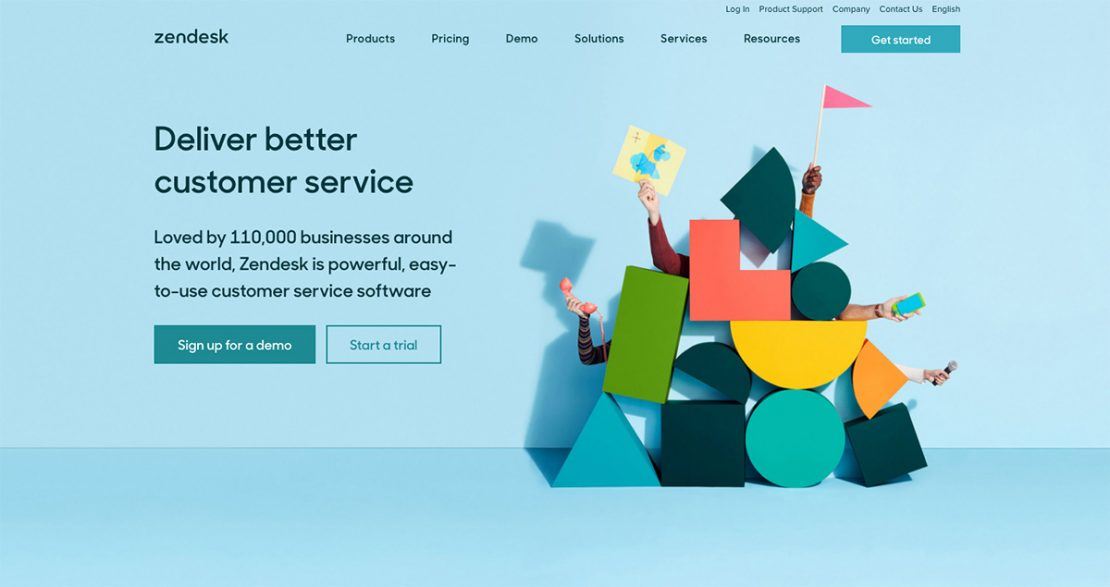
Dropbox also provides a free trial for its file sharing service, whether you’re an individual or run a business.
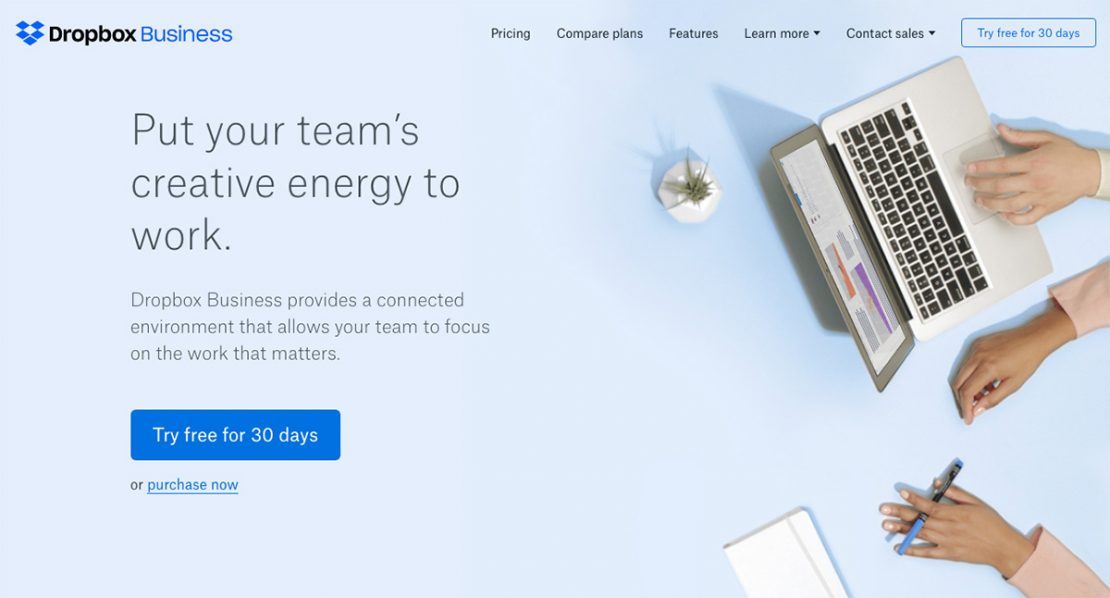
And then there’s Slack, which you can use for free with as many users as you like as long as you don’t need archiving.
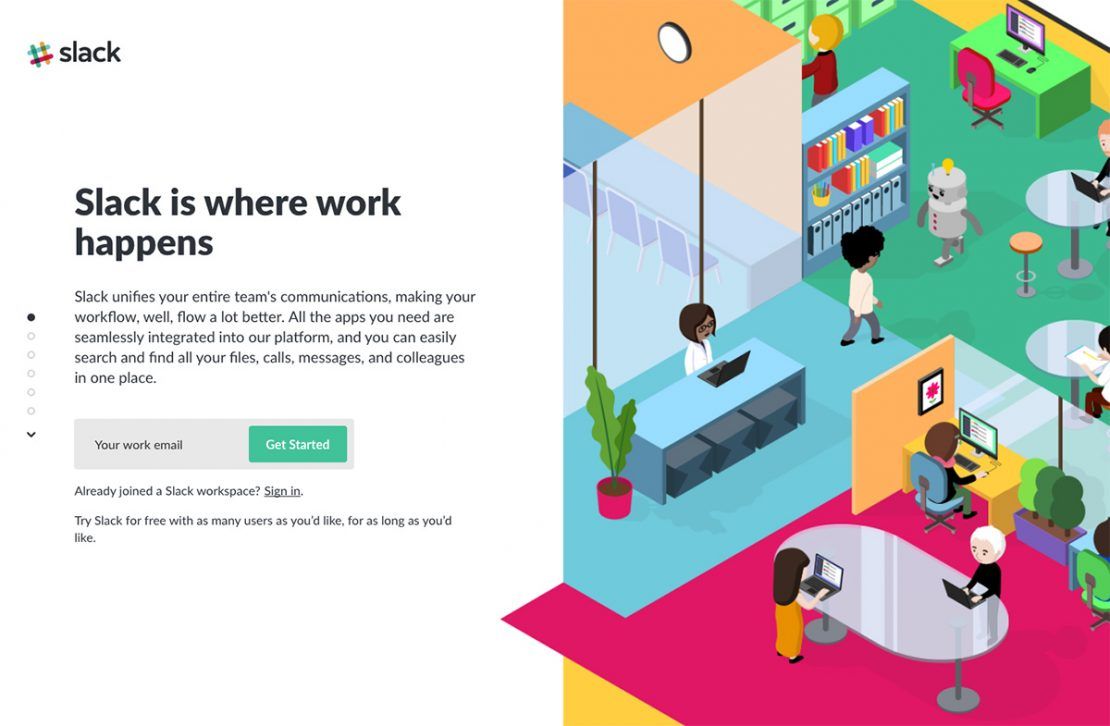
Central to the free trial/plan strategy is customer onboarding. A successful onboarding campaign should focus on meeting (and hopefully exceeding) the customer’s expectations. It should also educate the customer about your company’s value and encourage them to continue paying recurring fees for your service.
While I won’t go into detail about onboarding here, Kissmetrics describes onboarding as the “secret sauce to reducing SaaS churn.” Well worth reading.
Content is King
There’s a reason why the best SaaS companies have amazing blogs and resources. In the fast-paced world of tech, businesses are working harder than ever to demonstrate their thought leadership and build their credibility by offering free information — articles, podcasts, interviews, reviews, tips, how-to’s, ebooks, and guides.
This quality content enables SaaS companies to promote their value and expertise and help potential customers get to know your brand.
When a customer sees that you’re providing quality, cutting-edge insights and solutions to their problems, it’s incredibly persuasive — why would they sign up with a competing service when you’re obviously the authority in your niche?
Take Hubspot, for example. Search for any marketing topic and you’re likely to find one of their posts on the first page of Google results. Through publishing high-quality articles, Hubspot is able to showcase its deep industry knowledge, which in turn reflects its brand and the quality of its marketing services.
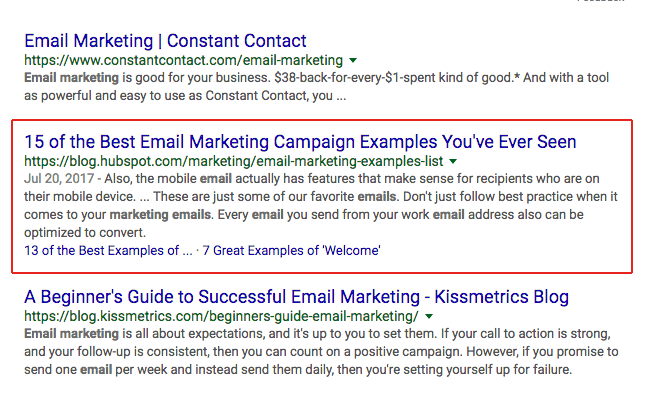
Developing a comprehensive content marketing plan is key as it will not only help nurture new leads but also continue to educate existing customers.
It’s also worth mentioning SEO — you can’t have content marketing without SEO, they’re intrinsically linked. I won’t go into detail, but it’s important to have a solid SEO plan in place that works alongside your content marketing strategy.
Sharing is Caring
While social media marketing for SaaS isn’t all that different from marketing physical products, it does offer many benefits.
You can use social media to build brand recognition and visibility for your service, develop relationships with existing customers, provide support to your customer base and even nurture potential sales.
On top of all that, any work you’re doing around social media marketing should take into account your content marketing and SEO plans. So it’s important that the social, content and SEO plans you have in place complement one another.
There are lots of great examples of SaaS companies that have nailed their social media marketing, but none more so than Zendesk and it’s crazy marketing ploy- Zendesk Alternative.
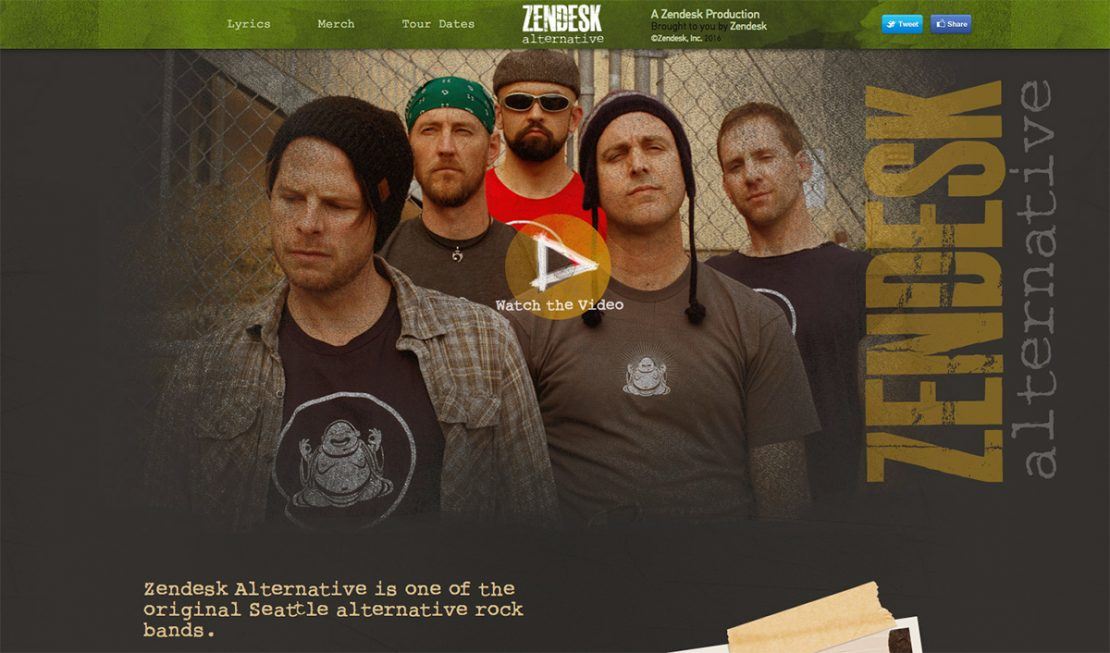
The customer service platform noticed that people were using the keywords “Zendesk alternative” to find other platforms like Zendesk. So the company set out to win some organic search traffic by setting up its own Zendesk alternative… band.
They invented a fake alternative music band, Zendesk Alternative, and even created videos, lyrics, a website, social media accounts. The marketing team even went so far as to list the band name on Bandcamp.
The results? The fake site converted at a 95% higher rate than the main website. It might’ve cost Zendesk a lot of money to put together, but won over customers with its wit and charm despite poking fun at the competition.
Join Forces to Expand Your Reach
Cross-promotional marketing provides a powerful and relatively inexpensive way to reach a whole new user base of potential customers.
By partnering with a company that sells a complimentary service for your business, you can cross-promote each other, tapping into each other’s customer base. It’s a powerful way to reach new customers because you gain a credible introduction.
Exactly how you cross-promote is up to you. It could be something as simple as publishing a positive review on your blog about the other business or offering your service at a discounted rate in a one-off email, and the other business doing the same for you.
There are more ideas you could try in this great post on the balance about cross-promotional marketing.
Hold Onto Your Customers
Your existing customers are your bread and butter — according to Gartner, a full 80% of all future revenue will come from just a fraction (20%) of your current customers.
Data also shows that, on average, loyal customers are worth 10 times their initial transaction, and they’re 65% easier to sell to than first-timers. In addition, studies show that just a 5% increase in customer retention can boost a business’s profits by 25% to 95%.
This means customer retention is critical to your company’s long-term success. If your churn rate is too high, it doesn’t matter how amazing your marketing strategy is at generating new leads because your customers aren’t sticking around.
Once you acquire a customer, the sale doesn’t end there: it’s the beginning of a relationship that continues with actually providing a quality service and meeting their ongoing needs. Satisfied customers will renew their subscriptions each month and keep coming back.
To keep your customers happy, have a strategy in place to market to your existing customer base. Offer special promotions to your customer throughout the year. For more customer retention strategies, check out Help Scout’s useful tips.
It’s also worth creating a referral program. After all, word of mouth is powerful stuff. When happy customers tell their friends and colleagues about your SaaS, it’s incredibly valuable.
Creating a referral program can help you encourage customers to spread the word. Try offering existing customers a free month of your service or some other reward for referring new customers. Shopify has some great tips here about launching a referral program.
Software as a Service
The keyword here is service. While it’s important to provide top-notch services that serve your customers’ needs, the word “service” implies a personal touch. As such, customer satisfaction and providing stellar customer support is hugely important.
Make it easy for customers to get in touch with you. Provide multiple channels for support. This might include live chat, email, social media, and forums.
Provide exhaustive resources, FAQs, knowledge base and guides to help customers understand and navigate your services. Leave no stone unturned here — solve as many problems as you can.
Overall your goal should also be to delight users. Take MailChimp, for example. When I was having a problem with updating a template, I fired up live-chat to talk to someone on their customer support team. At the end of the chat, they asked for my address so they could mail me a t-shirt. Not for any particular reason, just because. A few weeks later, I got my t-shirt in the mail. I still have it four years later.
Another classic example that has done the rounds on social media is Freshbooks. The invoicing and accounting SaaS sends cakes to its loyal customers. Pretty cool, right?

You don’t need to send customers cake to win brownie points — you just need to keep them happy. This is as simple as improving your response times and providing comprehensive answers to their questions.
Whatever you do, customer support is important and absolutely essential to the long-term success of your SaaS.
Paid Advertising
Let’s get one thing out of the way first: investing in paid advertising can be powerful when your SaaS company is new and trying to gain traction but it’s not all that effective as a long-term marketing strategy.
Why? Well, everyone is doing it so it can be difficult to stand out from the crowd.
Thanks in part to competition and also rising PPC costs, advertising using mediums like Google or Facebook can cost an arm and a leg.
It’s also important to keep in mind that there’s no real growth attached to paid advertising. When you invest time and money into other forms of marketing, like content, SEO and social, you get back ROI in the long-term. In comparison, as soon as you stop paying for your ads, that’s it, no more ROI.
So while paid advertising, like native ads, can be helpful in the short term, long term it’s worth investing in other forms of inbound marketing.
Conclusion
When it comes down to it, there are two absolutely essential elements that underpin any successful SaaS marketing strategy: creating and maintaining an amazing service and providing exceptional customer support.
Unlike traditional marketing, SaaS marketing relies heavily on developers, support teams, and marketers working closely together. Having a great product will help generate word of mouth and there’s no better way to sell your SaaS, really. In turn, delighting your customers with excellent customer support will further increase your value.
What strategies do you have in place to market your SaaS? What marketing tactics would you like to learn more about? Share your thoughts in the comments below.
